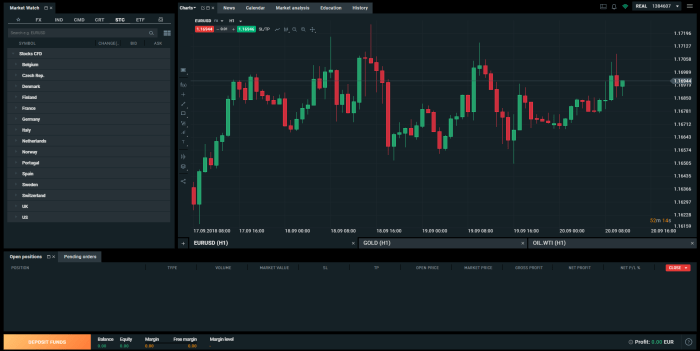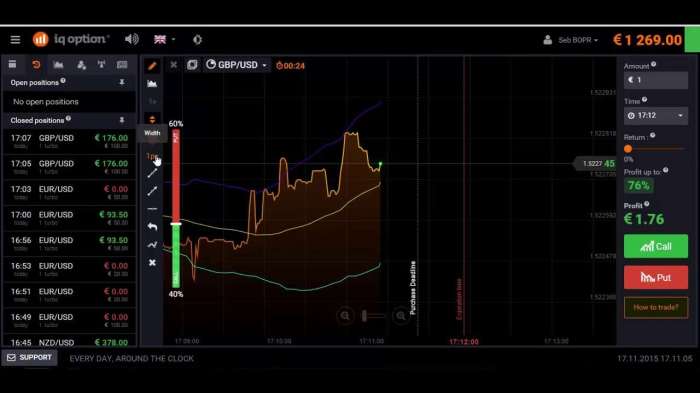
Crypto and forex trading—two seemingly disparate worlds, yet both teeming with opportunity and risk. This isn’t your grandpappy’s stock market; we’re talking volatile digital assets and global currencies, a thrilling rollercoaster of potential profits and gut-wrenching losses. Understanding the nuances of both markets is key to navigating this complex landscape, from mastering technical analysis to developing a rock-solid risk management strategy. Get ready to decode the secrets of success in these high-stakes arenas.
We’ll dissect the similarities and differences between crypto and forex, comparing regulatory environments, exploring various trading instruments, and analyzing the inherent volatility of each. We’ll delve into diverse trading strategies, from scalping to swing trading, and examine the crucial role of fundamental and technical analysis. Risk management, often the unsung hero of successful trading, will be thoroughly explored, along with the psychological factors that can make or break a trader’s journey. Finally, we’ll examine real-world examples, showcasing both triumph and tribulation in the exciting worlds of crypto and forex.
Market Overview: Crypto And Forex Trading
Navigating the worlds of crypto and forex trading can feel like venturing into two distinct universes, yet they share surprising similarities while maintaining crucial differences. Understanding these nuances is key to successful trading in either market. Both offer opportunities for high returns, but also expose traders to significant risks. Let’s delve into the key distinctions and commonalities.
Regulatory Landscapes of Crypto and Forex Markets
The regulatory landscape is a significant differentiator. Forex markets, generally speaking, are heavily regulated, with established bodies like the Commodity Futures Trading Commission (CFTC) in the US and the Financial Conduct Authority (FCA) in the UK overseeing transactions and protecting investors. These regulations cover aspects like licensing, capital requirements, and client segregation. In contrast, the crypto market is largely decentralized and faces a patchwork of regulations that vary significantly across jurisdictions. Some countries have embraced a more hands-off approach, while others are actively developing comprehensive regulatory frameworks. This lack of uniform regulation creates both opportunities and risks for crypto traders. The regulatory uncertainty can impact market stability and investor confidence.
Trading Instruments in Crypto and Forex Markets
Both markets offer a range of trading instruments, although the specific offerings differ. Forex trading primarily involves trading currency pairs (e.g., EUR/USD, GBP/JPY) through spot trading (immediate exchange), forwards (agreement to exchange currencies at a future date), futures (standardized contracts to buy or sell a currency at a specific price and date), and options (giving the right, but not the obligation, to buy or sell a currency at a certain price by a certain date). Crypto markets also feature spot trading, allowing for immediate buying and selling of cryptocurrencies. However, they also offer futures and options contracts on various cryptocurrencies, mirroring the forex market’s structure. The availability of these instruments can vary depending on the exchange and the specific cryptocurrency. Furthermore, crypto markets offer unique instruments like decentralized finance (DeFi) products and non-fungible tokens (NFTs), which are not found in traditional forex trading.
Volatility and Risk Profiles of Crypto and Forex Assets
The volatility and risk associated with crypto and forex trading are markedly different.
| Asset Class | Typical Volatility | Risk Profile | Example |
|---|---|---|---|
| Forex (Major Pairs) | Moderate | Medium to Low (depending on leverage) | EUR/USD fluctuations generally remain within a predictable range. |
| Forex (Emerging Market Currencies) | High | High (due to political and economic instability) | The Argentinian Peso can experience significant daily swings. |
| Cryptocurrencies (Bitcoin, Ethereum) | Very High | Very High (subject to market sentiment and technological developments) | Bitcoin’s price has experienced dramatic increases and decreases in short periods. |
| Cryptocurrencies (Altcoins) | Extremely High | Extremely High (often highly speculative and susceptible to scams) | Many smaller cryptocurrencies have seen massive price swings, often followed by significant drops. |
Trading Strategies

Navigating the volatile worlds of crypto and forex requires a robust understanding of various trading strategies. Success hinges not just on market timing, but on a well-defined approach that aligns with your risk tolerance and investment goals. This section explores common strategies employed in both markets, highlighting their similarities and differences.
Technical Analysis Indicators
Technical analysis uses past market data to predict future price movements. Both crypto and forex traders rely heavily on indicators to identify trends, support levels, and potential reversal points. Popular indicators include moving averages (like the simple moving average and exponential moving average), which smooth out price fluctuations to reveal underlying trends. Relative Strength Index (RSI) measures momentum and helps identify overbought or oversold conditions, signaling potential price reversals. The MACD (Moving Average Convergence Divergence) indicator identifies changes in momentum by comparing two moving averages. Bollinger Bands show price volatility and potential breakout points. These indicators, while useful, should be used in conjunction with other forms of analysis for a more comprehensive view.
Fundamental Analysis Techniques
Fundamental analysis focuses on the underlying factors influencing asset prices. In forex, this involves examining macroeconomic indicators like inflation rates, interest rates, GDP growth, and political stability of countries whose currencies are being traded. For example, a rising interest rate in a country typically strengthens its currency. In crypto, fundamental analysis involves assessing the technology behind a cryptocurrency, its adoption rate, the strength of its development team, regulatory landscape, and overall market sentiment. For instance, positive news about a cryptocurrency’s development or increased adoption by businesses can boost its price. However, the crypto market is often influenced by speculation and hype, making fundamental analysis more challenging than in the forex market.
Algorithmic Trading Strategies
Algorithmic trading, or automated trading, involves using computer programs to execute trades based on pre-defined rules and algorithms. In both forex and crypto, this allows for faster execution of trades and the implementation of complex strategies that would be impossible for a human trader to manage manually. Common algorithmic strategies include mean reversion strategies (which exploit temporary price deviations from the average), arbitrage (exploiting price differences across different exchanges), and trend-following strategies (capitalizing on established price trends). However, algorithmic trading requires significant technical expertise and careful risk management to avoid substantial losses. A well-designed algorithm needs to incorporate robust error handling and adapt to changing market conditions.
Comparison of Scalping, Day Trading, and Swing Trading
The choice of trading strategy significantly impacts risk and potential returns. Here’s a comparison across scalping, day trading, and swing trading in both forex and crypto markets:
- Scalping: This involves holding positions for very short periods (seconds to minutes), aiming for small profits from numerous trades. It’s high-frequency trading with high transaction costs and requires significant technical expertise and fast internet connections. Both forex and crypto markets offer opportunities for scalping, but the volatility of crypto can make it riskier.
- Day Trading: Positions are held for a single trading day, aiming for profits from daily price fluctuations. It requires constant market monitoring and a good understanding of technical analysis. Both forex and crypto are suitable for day trading, but the 24/7 nature of crypto markets demands more attention.
- Swing Trading: Positions are held for several days to weeks, aiming to capitalize on medium-term price swings. This strategy involves identifying potential support and resistance levels and requires less active monitoring than day trading. Both forex and crypto markets allow for swing trading, but the longer holding periods in crypto might expose traders to greater risks due to potential market crashes.
Risk Management
Navigating the volatile worlds of crypto and forex trading requires a steely nerve and a robust risk management strategy. Without it, even the most brilliant trading ideas can quickly turn into substantial losses. This section delves into practical strategies to protect your capital and ensure longevity in these exciting, yet unpredictable markets. Remember, smart trading isn’t just about making profits; it’s about preserving your hard-earned money.
Position Sizing in Crypto and Forex Trading
Determining the appropriate amount to invest in each trade is crucial. Over-leveraging can amplify losses exponentially, while under-leveraging limits potential profits. A common approach is to risk only a small percentage (typically 1-2%, but this is highly personal and depends on your risk tolerance and trading style) of your total trading capital on any single trade. This percentage should be consistently applied across all your trades. For instance, if your trading capital is $10,000 and you risk 1%, your maximum loss per trade should be $100. This helps to limit potential damage even if several trades go against you. Adjusting this percentage based on your experience and confidence level is acceptable, but always err on the side of caution, especially when starting out.
Stop-Loss Orders: A Safety Net
Stop-loss orders are your safety net in the turbulent seas of trading. These orders automatically sell your asset when it reaches a predetermined price, limiting your potential losses. In crypto, stop-loss orders can be set on exchanges, protecting you from sudden price drops. Similarly, in forex, stop-loss orders are integral to managing risk and preventing significant losses. It’s crucial to place stop-loss orders slightly below key support levels for long positions and slightly above key resistance levels for short positions. Remember that slippage (the difference between the expected execution price and the actual execution price) can occur, especially during periods of high volatility. Therefore, setting your stop-loss slightly wider than your intended level can offer additional protection.
Diversification and Hedging Techniques
Don’t put all your eggs in one basket. Diversification involves spreading your investments across various assets, reducing the impact of a single asset’s poor performance. In crypto, this might mean investing in different cryptocurrencies with varying market capitalizations and use cases. In forex, diversification could involve trading multiple currency pairs with low correlation. Hedging, on the other hand, involves taking offsetting positions in related assets to reduce risk. For example, if you’re long on a particular cryptocurrency, you might hedge by shorting a similar cryptocurrency or a related asset that is negatively correlated. This strategy isn’t foolproof, but it can significantly reduce your overall risk exposure.
Developing a Personal Risk Management Plan, Crypto and forex trading
A well-defined risk management plan is your roadmap to success in trading. Follow these steps to create yours:
- Define Your Risk Tolerance: Honestly assess how much loss you can comfortably absorb without impacting your overall financial well-being. This is subjective and personal.
- Set a Maximum Loss per Trade: Determine the percentage of your trading capital you’re willing to risk on each trade. Start conservatively (1-2%) and adjust as your experience grows.
- Implement Stop-Loss Orders: Consistently use stop-loss orders to limit potential losses on each trade. This is non-negotiable.
- Diversify Your Portfolio: Spread your investments across different assets to mitigate the risk of substantial losses from a single asset’s poor performance.
- Regularly Review and Adjust: Your risk management plan isn’t set in stone. Regularly review its effectiveness and make adjustments as needed, based on market conditions and your trading performance.
- Maintain a Trading Journal: Record your trades, including your entry and exit points, stop-loss levels, and the rationale behind each trade. This will help you analyze your performance and identify areas for improvement.
Technological Aspects
Navigating the dynamic worlds of crypto and forex trading requires more than just market savvy; it demands a deep understanding of the technological tools that power these markets. The right platform and the right tools can significantly impact your trading success, offering features that streamline your workflow and enhance your decision-making process. Conversely, a poorly chosen platform can lead to frustrating experiences and potentially costly mistakes. Let’s dive into the technological landscape of both markets.
The platforms and tools available to crypto and forex traders have evolved significantly, offering increasingly sophisticated features. While both markets utilize online platforms for trading, the specific features and functionalities vary considerably, reflecting the inherent differences between the two asset classes.
Discover the crucial elements that make forex trading apps in india the top choice.
Trading Platform Comparison: Crypto vs. Forex
Forex and crypto trading platforms share some similarities but also exhibit key differences. Forex platforms, often provided by established brokers, typically offer a wider range of order types, charting tools with advanced technical indicators, and robust risk management features. Crypto platforms, on the other hand, often emphasize ease of use and access to a wider array of cryptocurrencies, sometimes with built-in wallets for storage. Many forex platforms are established and regulated, while the regulatory landscape for crypto platforms is still evolving. The level of security and customer support also varies considerably across platforms in both markets. For example, a well-established forex broker might offer advanced charting tools and multiple order types, whereas a crypto exchange might prioritize user-friendly interfaces and quick transaction speeds.
Key Features of Reliable Trading Platforms
A reliable trading platform, regardless of whether it’s for forex or crypto, should possess several essential features. Security is paramount, including robust encryption and measures to protect against hacking and fraud. A user-friendly interface is crucial for both beginners and experienced traders. Real-time data feeds are essential for making informed trading decisions. Advanced charting tools, including various technical indicators and drawing tools, are also highly beneficial. Finally, reliable customer support is critical for addressing any issues or questions that may arise. For instance, a platform with two-factor authentication and regular security audits would be considered more secure. A platform with intuitive navigation and clear visual representations of data would be considered user-friendly.
The Role of APIs and Automated Trading Bots
Application Programming Interfaces (APIs) and automated trading bots are transforming both the crypto and forex markets. APIs allow traders to connect their trading platforms to third-party applications and tools, enabling automated trading strategies, data analysis, and portfolio management. Automated trading bots, also known as algorithmic trading systems, execute trades based on pre-defined rules and algorithms. These tools can help traders to manage their positions more efficiently and to react to market changes quickly. However, it’s crucial to remember that while APIs and bots offer potential advantages, they also carry inherent risks, particularly if not properly configured or monitored. For example, a poorly designed trading bot could lead to significant losses if market conditions change unexpectedly.
Essential Tools and Resources for Traders
Choosing the right tools can significantly enhance your trading performance.
Here’s a list of essential resources for both crypto and forex traders:
- Trading Platform: A reliable and user-friendly platform with advanced charting tools and order types.
- Charting Software: Tools for technical analysis, including various indicators and drawing tools (TradingView, MetaTrader).
- News and Market Analysis Websites: Stay updated on market trends and news (Bloomberg, Investing.com, CoinDesk).
- Economic Calendar: Track important economic events that can impact forex markets.
- Risk Management Tools: Calculators and software to help manage risk effectively.
- Cryptocurrency Wallets (for Crypto): Secure storage for your digital assets.
- Spreadsheets or Portfolio Tracking Software: For managing and monitoring your trades and portfolio.
The Psychological Aspect of Trading
The allure of quick profits in the volatile worlds of crypto and forex trading can be intoxicating, but beneath the surface of potential riches lies a treacherous landscape of emotional turmoil. Success in these markets hinges not just on technical analysis and strategic planning, but crucially, on mastering the psychological game within yourself. Understanding and managing your emotions is as vital as understanding market trends.
The emotional rollercoaster inherent in trading can be intense. Fear, greed, hope, and despair are constant companions, often leading to impulsive decisions that erode profits and even wipe out accounts. This section delves into the psychological challenges traders face and offers strategies for navigating this emotional minefield.
Emotional Challenges in Crypto and Forex Trading
The high-stakes nature of both crypto and forex trading breeds intense emotional responses. The rapid price fluctuations, unpredictable market events, and the constant pressure to make the right call can trigger a cascade of emotions. For instance, the fear of missing out (FOMO) can lead to rash investments, while the fear of loss can paralyze decision-making, resulting in missed opportunities. Conversely, excessive greed can cause traders to hold onto losing positions for too long, hoping for a turnaround that may never come. These emotional swings can easily cloud judgment and lead to poor trading decisions.
Strategies for Managing Emotions and Maintaining Discipline
Developing emotional intelligence is paramount for consistent trading success. This involves self-awareness – recognizing your emotional triggers and how they impact your trading – and self-regulation – employing techniques to manage those emotions effectively. A key strategy is to establish a detailed trading plan, outlining entry and exit points, risk tolerance levels, and position sizing. Sticking to this plan, regardless of emotional impulses, is crucial. Furthermore, maintaining a trading journal to track performance, analyze mistakes, and identify emotional biases can provide valuable insights and improve self-awareness. Regular breaks from trading to prevent emotional burnout are also essential. Practicing mindfulness and meditation techniques can also help to cultivate a calm and focused mindset.
Risk Tolerance Assessment and its Application
Accurately assessing your risk tolerance is a foundational step in responsible trading. This involves understanding how much potential loss you can comfortably withstand without significantly impacting your financial well-being or emotional stability. In forex, this might involve calculating the maximum amount you’re willing to lose on a single trade or within a specific period. Similarly, in crypto, it involves understanding the volatility of different assets and setting appropriate position sizes. A proper risk assessment ensures that trading remains a calculated venture rather than a gamble. Tools like risk-reward ratios and stop-loss orders are crucial in implementing a risk management strategy aligned with your assessed tolerance. For example, a conservative trader might only risk 1% of their capital per trade, while a more aggressive trader might risk 2-3%. However, exceeding a pre-defined risk threshold should be avoided.
Cognitive Biases Affecting Trading Decisions
Several cognitive biases can significantly impair judgment and lead to poor trading decisions.
- Confirmation Bias: The tendency to seek out and interpret information that confirms pre-existing beliefs, while ignoring contradictory evidence. For example, a trader might only focus on news that supports their bullish outlook on a particular cryptocurrency, neglecting bearish signals.
- Overconfidence Bias: An inflated sense of one’s own abilities, leading to excessive risk-taking and neglecting proper risk management. A trader might believe they can consistently predict market movements, leading to larger position sizes and increased risk.
- Anchoring Bias: Over-relying on the first piece of information received (the “anchor”) when making decisions. A trader might base their entry price on the initial price they saw, even if subsequent market analysis suggests a more favorable entry point.
- Availability Heuristic: Overestimating the likelihood of events that are easily recalled, often due to their recency or vividness. For instance, a trader might overestimate the probability of a market crash after experiencing a recent significant downturn.
- Loss Aversion: The tendency to feel the pain of a loss more strongly than the pleasure of an equivalent gain. This can lead to holding onto losing positions for too long, hoping for a recovery, rather than cutting losses.
Illustrative Examples

Real-world examples illuminate the principles of successful crypto and forex trading. Understanding these case studies helps solidify theoretical knowledge and provides practical insights for navigating the complexities of these volatile markets. Let’s examine some successful strategies and risk management techniques.
Successful Crypto Trading Strategy: Arbitrage
Arbitrage exploits price discrepancies between different cryptocurrency exchanges. Imagine Bitcoin (BTC) trading at $30,000 on Exchange A and $30,100 on Exchange B. A trader could simultaneously buy BTC on Exchange A and sell it on Exchange B, pocketing a $100 profit per Bitcoin, minus transaction fees. This strategy relies on speed and efficient execution to capitalize on fleeting price differences. The rationale is simple: profit from market inefficiencies. The success hinges on identifying these discrepancies quickly and having the technological infrastructure to execute trades efficiently before the price difference disappears.
The key to successful crypto arbitrage is speed and low transaction fees. A delay of even a few seconds can negate the profit potential.
Successful Forex Trading Strategy: Carry Trade
The carry trade involves borrowing money in a low-interest-rate currency and investing it in a high-interest-rate currency. For example, a trader might borrow Japanese Yen (JPY) at a low interest rate and invest in the Brazilian Real (BRL) which offers a significantly higher interest rate. The profit comes from the interest rate differential, but it’s crucial to manage the exchange rate risk. If the JPY appreciates against the BRL during the investment period, the trader could lose money. The rationale is to profit from the interest rate differential, but careful risk management is paramount.
Successful carry trades require a deep understanding of interest rate differentials and exchange rate dynamics. Hedging strategies are essential to mitigate potential losses.
Successful Risk Management in Crypto: Stop-Loss Orders
A trader holding Bitcoin at $30,000 might set a stop-loss order at $28,000. This automatically sells the Bitcoin if the price drops to that level, limiting potential losses. During a sudden market downturn, this prevents catastrophic losses. For instance, imagine a flash crash where Bitcoin drops 20% in minutes. A stop-loss order at $28,000 would protect the trader from significant losses, even though the price might fall further after the order is executed.
Stop-loss orders are a fundamental risk management tool in crypto trading, limiting potential losses during volatile market conditions.
Successful Risk Management in Forex: Diversification
Instead of focusing on a single currency pair, a forex trader might diversify across multiple pairs. For instance, they might invest in EUR/USD, GBP/USD, and USD/JPY. This reduces the impact of a negative event affecting one specific currency pair. If the EUR/USD experiences a sharp decline, the gains from other pairs might offset the losses, reducing the overall portfolio risk.
Diversification is a cornerstone of forex risk management, mitigating the impact of adverse events affecting individual currency pairs.
Market Event Impact: Crypto – 2022 Bear Market
The 2022 crypto bear market saw a significant decline in the value of most cryptocurrencies. Factors like rising interest rates, regulatory uncertainty, and the collapse of TerraUSD (UST) contributed to the downturn. Bitcoin’s price plummeted from an all-time high to below $20,000, impacting many investors. Traders who hadn’t implemented proper risk management strategies, such as stop-loss orders, suffered significant losses.
The 2022 crypto bear market highlighted the importance of risk management and diversification in navigating periods of extreme volatility.
Market Event Impact: Forex – 2008 Financial Crisis
The 2008 financial crisis had a profound impact on the forex market. The collapse of Lehman Brothers triggered widespread uncertainty and risk aversion. Major currencies experienced significant volatility, and many currency pairs experienced sharp declines. Traders who hadn’t adequately hedged their positions or diversified their portfolios experienced substantial losses. The crisis underscored the interconnectedness of global financial markets and the importance of anticipating and mitigating systemic risks.
The 2008 financial crisis demonstrated the significant impact of global events on forex markets and the importance of robust risk management strategies.
Last Word

The journey into the worlds of crypto and forex trading is a challenging but potentially rewarding one. Mastering technical analysis, developing a robust risk management plan, and understanding the psychological aspects of trading are paramount. While the allure of quick riches is undeniable, a disciplined approach, coupled with continuous learning, is the key to long-term success. So, buckle up, because the ride is far from over. The future of finance is here, and it’s waiting to be explored.
Enhance your insight with the methods and methods of trading de divisas forex.




